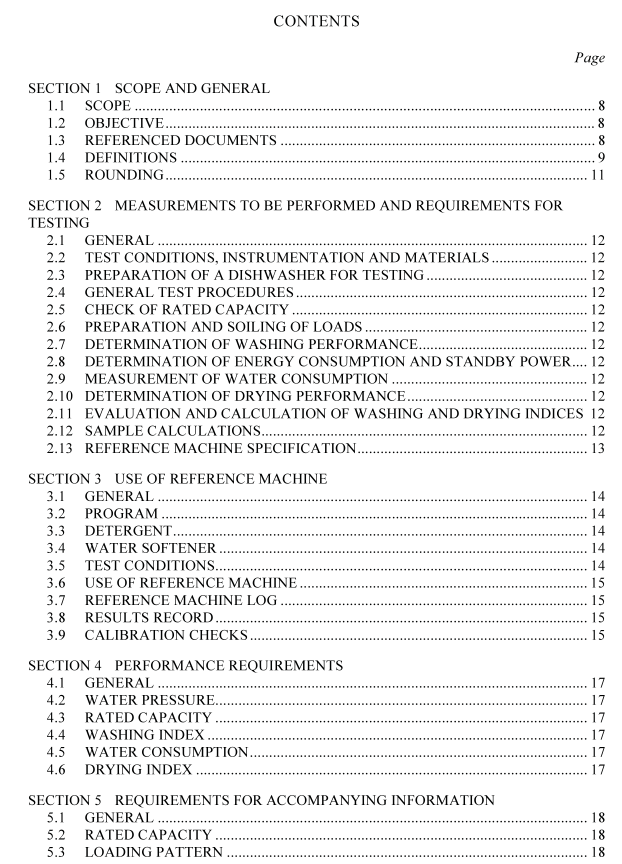AS NZS 2007.1 pdf download – Performance of household electrical appliances—Dishwashers Part 1: Methods for measuring performance, energy and water consumption

AS NZS 2007.1 pdf download – Performance of household electrical appliances—Dishwashers Part 1: Methods for measuring performance, energy and water consumption
1.4 DEFINITIONS For the purposes of this Standard the definitions below apply. NOTE: The following defined terms have been bolded throughout this Standard.
1.4.1 Cycle The cycle is the series of operations and other activities that occur within the cycle time.
1.4.2 Cycle time Cycle time is measured from the initiation of the program (excluding any user programmed delay) until all activity ceases. Activity is considered to have ceased when the power consumption reverts to a steady state condition that persists indefinitely without user intervention. If there is no activity after the end of the program, the cycle time is equal to the program time. NOTE: Cycle time includes any activity that may occur after the program is completed until a steady state condition is reached. This could include fans, any electronic activity or any additional mechanical activity that occurs for a limited period after any end of program indicator. Any cyclic event that occurs indefinitely is considered to be steady state. (Refer to Appendix M for examples.)
1.4.3 Delay start mode Delay start mode is where the model has a user option that is used to delay the commencement of the program. (See also Paragraph D5.)
1.4.4 Dishwasher A machine which cleans, rinses and dries dishware, glassware, cutlery, and, in some cases, cooking utensils by chemical, mechanical, thermal and/or electric means. A dishwasher may or may not have a specific drying operation at the end of the program.
1.4.5 End of cycle mode End of cycle mode is the state that the appliance enters at the end of the cycle. During end of cycle mode, appliance power is in a steady state condition that persists indefinitely. This mode is applicable to all products. (See also Paragraph D4.) NOTE: In some products this mode may be an equivalent power to off mode while in some products end of cycle mode will persist until off mode is initiated by the user via a power switch.
1.4.6 Off mode Off mode is present only on those appliances which have a power or off switch which is operated via controls that are intended to be normally accessible to the user. Off mode is activated where the appliance remains connected to the mains electricity supply and where the power or off switch is activated to put the appliance into a state where it is not in use and no short duration operations are in progress. Off mode is a state that persists until the user activates the product via the power or on switch. (See also Paragraph D6.) Note: In some products, some short term duration operations may be present for a period after off mode is initiated. An off or power switch may be present as a separate user operated control or may be integrated into another device operated by the user such as a door.
1.4.7 Operation
Each event that occurs during the dishwasher cycle, such as cleaning, rinsing or drying.
1.4.8 Place setting
One place setting consists of one each of the following items:
(a) Crockery
Items specified in Paragraph A12.2.1 or A12.3.
(b) Glassware
Items specified in Paragraph A12.2.2 or A12.3.
(c) Cutlery
Items specified in Paragraph A12.2.3 or A12.3.
1.4.9 Program
Series of operations which are pre-defined within the dishwasher, and which are declared as suitable for specified levels of soil and/or type of load.
1.4.10 Program time Program time is measured from the initiation of the program (excluding any user programmed delay) until the end of program is indicated. If the end of program is not indicated, the program time is equal to the cycle time.
NOTE: The end of the program is intended to be the earliest point where the consumer would normally be able to access the load, which at this time meets all performance requirements for the program.
1.4.11 Rated capacity The whole number of place settings stated by the manufacturer, which can be cleaned and dried when loaded in accordance with the manufacturer’s instructions.









